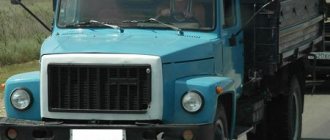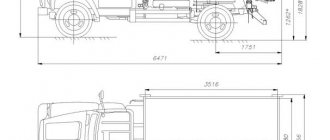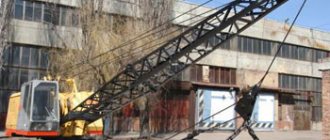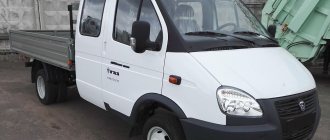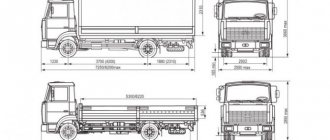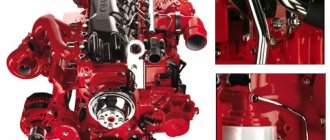GAZ 3507 is a medium-tonnage truck with an all-metal body, built on the basis of the GAZ 3307 (GAZ 3309) chassis. The series has a double designation (GAZ-SAZ 3507), since the production of vehicles on this platform is also carried out by the Saransk Dump Truck Plant. The design of the vehicle allows for unloading on several sides.
GAZ 3507 is a reliable and practical truck, practically not inferior to foreign competitors in terms of quality and technical parameters. The model has won many awards and was designed specifically for use in difficult Russian conditions.
PURPOSE
GAZ 3507 is actively used for transporting agricultural products and bulk materials on asphalt or dirt roads in Eastern Europe, Asia and Russia. The series was created for areas with a temperate climate, but has proven itself well in other regions.
The vehicle is equipped with a special superstructure for performing mechanized unloading on 3 sides. Thanks to this, the scope of application of the GAZ 3507 is significantly expanding. To increase the volume of transported cargo, a set of extension sides (rear, front and 2 side) with panels made of metal mesh or metal sheet is used. Such features provide the machine with additional advantages over its competitors.
GAZ SAZ-3507 Saransk dump truck plant
Initially, the GAZ 3507 dump truck was developed exclusively for use in the agricultural sector, since its technical characteristics allow it to be driven on poor quality roads. However, thanks to numerous advantages, the vehicle has become a truly universal solution for transporting goods.
According to the official data of the manufacturer, indicated in the documentation supplied with the car, it is not intended for transporting concrete, various solutions for construction purposes, or for use in quarries. This is due to the specific design of the vehicle, which involves transportation of:
- grains;
- manure, other fertilizers;
- silo;
- sand, gravel and small stones.
The vehicle drives well on bad roads. Failure to follow the manufacturer's recommendations can lead to rapid breakdown of key components of this truck. Most often, malfunctions are observed in the dump truck tipping mechanism, as well as related components. The design of the car does not imply the possibility of installing a coupling device, since its use can also lead to serious damage.
Description of the car
If you look at the photo of this kind of model, you can note that its design is fully consistent with the year of manufacture and is currently frankly outdated. Nevertheless, many cars in this series continue to be actively used to this day, due to their excellent performance and reliable design.
GAZ SAZ was equipped with a set of extension sides made of sheet metal or mesh. To increase the service life of the vehicle, the manufacturer recommended reducing the load on it to 75% of the maximum established values during the break-in period. However, it is not recommended to use a car to transport goods weighing more than 4 tons.
Be sure to read: Hyundai Porter
The truck is designed for use in areas with temperate climates, where temperatures range from +45 to -45 degrees. There are 2 modifications of this car, which differ in the type of power unit. Z5071 is a standard diesel truck, and modification 01 assumes the presence of a gasoline unit.
STORY
In Soviet times, the Gorky Automobile Plant was considered one of the main manufacturers of medium-duty trucks. After the collapse of the USSR, the company lost its position, but some models of the brand remain in high demand on the market.
GAZ 3507 is one of the latest products of the Gorky Automobile Plant. Production of the car started in 1984. The well-proven GAZ 3307 was used as the basis for its creation. The model was a great success in the Union republics, but by the beginning of the 1980s it began to become obsolete. The developers wanted to create a new model at minimal cost and preserve the advantages of its predecessor. As a result, the priority became maximum unification of elements and nodes. Many units and parts of the GAZ 3307 were “migrated” into the design of the GAZ 3507, which made it possible to significantly save on the development process. The design has remained virtually unchanged. GAZ 3507 received the cabin of its predecessor with a large hood, standard angular shapes and a large radiator grille. The cabin of the new series has become larger and has improved heating and ventilation systems.
The GAZ 3507 differed from the previous version by a rear frame shortened by 152 mm. Changes in appearance were minimal. The spare wheel has moved 272 mm back. The towing hooks used in the GAZ 3307 were replaced with a towing device. The casing and floor mats have been completely changed. The remaining elements have been preserved in the same format.
Transformations took place in the engine line. GAZ 3507 was considered as a transitional series, which was supposed to be replaced by a more economical and modern model. To achieve this goal, in the early 1990s, the Gorky Automobile Plant opened the production of its own engines, but after the collapse of the USSR, the enterprise was gripped by a severe crisis. As a result, car production decreased noticeably, and the transitional model is still available on the market today.
Initially, the new series consisted of 2 modifications: GAZ 3507 (a dump truck based on the GAZ 3307 with a ZMZ-5231 gasoline engine, a load capacity of 4.13 tons and a body volume of 5 cubic meters) and GAZ 35071 (a diesel variation with similar characteristics). In 1989, a new generation of GAZ 3307 was introduced, on the basis of which modifications GAZ 3507-01 and GAZ 35072 were created.
The series expanded in the 2000s. After the appearance of the GAZ 3309 chassis, the premiere of the new version of the GAZ 35071 took place. However, truck sales continued to decline.
In 2003, the Saransk Automobile Plant tried to revive the series and launched the GAZ 35072. The model was based on the GAZ 3309 chassis with the Belarusian D-245 diesel unit. The car had a 4.5 cubic meter body, one-sided unloading and had a load capacity of 4.25 tons. Compared to other versions of the GAZ 3507, the new product was much more economical and required 14 liters of fuel per 100 km, practically not inferior in power and traction to the classic version. In terms of design, the GAZ 35072 was no different from the base model.
In 2009, production of gasoline modifications ended.
GAZ 3507 remains in demand in the domestic market. The production of the series on a small scale continues to this day.
GAZ-SAZ-35071: design features :: SYL.ru
The production program of the GAZ plant has always included medium-duty trucks. The company produced them in the form of a full-fledged onboard version or in the form of a chassis, which was supplied to other enterprises to be equipped with various superstructures.
Dump truck on a new chassis
For many years in a row, the specialized Saransk dump truck plant was engaged in the production of dump trucks on the chassis of Gorky trucks. SAZ products were widely used in agriculture and public services.
In the second half of the 80s, the Gorky Automobile Plant mastered the production of a new basic GAZ 3307 truck with a gasoline engine. In 1994, production of a diesel version of the truck with index 3309 began. Both types of chassis are supplied to Saransk, where dump trucks with three-way unloading are assembled on them. The diesel version with a carrying capacity of 4000 kg is designated GAZ SAZ 35071.
Dump chassis use a frame shortened by 152 mm at the rear. There is no towing device on the rear cross member, but there are hooks on the side members. Another difference is the displacement of the spare wheel bracket closer to the rear axle.
With Gorky diesel engine
In its original form, the base chassis 3309 was equipped with a four-cylinder supercharged diesel engine GAZ 5441. The forced air-cooled engine developed power up to 116 hp. With. Externally, a diesel truck can be distinguished by a high pipe for air intake into the engine, located on the left side of the cab. The characteristics of the GAZ SAZ 35071 made it possible to very quickly displace less economical gasoline cars.
Tractor engine
But in mid-1997, production of 5441 series motors was suddenly declared unprofitable and suspended indefinitely. ZMZ gasoline engines were returned to equip the trucks. But soon the diesel came back, only now it was a four-cylinder MMZ D245.7, produced by a motor plant in Minsk.
Engines of this family are installed on common MTZ tractors. The automotive version of the engine is equipped with a modified liquid cooling system and turbine. Dump trucks with such a 125-horsepower engine retained the previous designation GAZ SAZ 35071.
Dump truck equipment
The car is equipped with a standard two-seater cab located behind the engine. Behind it, an all-metal platform with an area of about 8 m2 is installed on a separate auxiliary frame.
The side and rear sides are mounted on swivel hinges and can be folded back. The folding elements are equipped with mechanisms to facilitate closing. Side clamps are manual. Before unloading, the required element is secured. The standard platform has a side height of 62 cm. However, they can be increased to 1.25 m using standard extension panels. Thanks to such sides, the volume of the platform doubles, which is very convenient for transporting light and large cargo.
To tilt the GAZ SAZ 35071 platform, it is equipped with a telescopic cylinder with a hydraulic drive. This part consists of three sections that give a maximum stroke of 670 mm. The oil supply for the system is located in a 16-liter tank on the frame side member. Its filler neck has a filter and a level indicator. The second filter is installed on the oil supply line to the pump.
The pressure in the drive of the tipping system is created by a gear pump NSh 32UK-3 installed on the power take-off. Torque is taken to drive the pump from the gearbox intermediate shaft gear. The unloading direction is selected by the position of the control valve valves. To fix the platform in a raised state, there is a mechanical stop.
The unloading of GAZ SAZ 35071 is controlled from the driver’s cab. There are two levers for this - one turns on the power take-off, the second selects the direction of unloading. To install these levers in the cab, an original floor panel with cutouts is used.
www.syl.ru
MODIFICATIONS
- GAZ 3507 is a dump truck based on the GAZ 3307 with a ZMZ-5231 gasoline engine. The model was equipped with a body with 3-sided unloading and a capacity of 5 cubic meters;
- GAZ-SAZ 35071 is a modification with similar characteristics and a diesel engine. Equipping the new unit increased the total weight of the vehicle to 8090 kg. Initially, the D-245.7 installation was used; on the latest models it was replaced with a YaMZ-534 motor. For this version, a 5-seater cabin with 2 rows of seats was optionally offered;
- GAZ 35072 is a later version produced by the Saransk Automobile Plant. The car was equipped with a diesel unit and was intended for transporting construction materials. The side parts of the body are made beveled to increase the strength of the unit. The basic configuration included a protective canopy for the cabin. The capacity of the GAZ 35072 body was 5.4 cubic meters, the load capacity was 4000 kg. A protective awning was installed upon request;
- GAZ-SAZ 3507-01 - version with a gasoline unit with an exhaust gas neutralizer. On some modifications produced later than 2016, an improved engine with a fuel injection system was installed (environmental standard - Euro 4, power - 137 hp). GAZ-SAZ 3507-01 was equipped with a platform with a capacity of 5 cubic meters;
- GAZ-SAZ 35072-010 – a variant version with a modified platform lift design and one-sided unloading. The sides are made motionless, so unloading is only possible backwards. The basic body is designed for 5 cubic meters, extension sides allow you to increase the volume to 10 cubic meters.
Prices and car analogues
The cost of the new 35071 dump truck with 3-sided unloading, equipped with a YaMZ 534 engine, starts from 1.825 million rubles. The construction version 35072 will cost at least 1.5 million rubles. The price of cars on the secondary market starts from 60 thousand rubles, for 300-350 thousand rubles. You can purchase equipment in working condition with a set of spare parts. The competitors are dump trucks built by the SAZ plant on the basis of GAZon Next trucks, which have a comfortable cabin and improved characteristics.
SPECIFICATIONS
Overall dimensions (without extension sides/with extension sides):
- length – 6470/6470 mm;
- width – 2460/2460 mm;
- height – 2350/2870 mm;
- wheelbase – 3770/3770 mm;
- ground clearance - 265/265 mm.
The front track of the car is 1690 mm, the rear track is 1630 mm.
Characteristics of the cargo platform (without extensions/with extensions):
- length – 3516/3516 mm;
- width – 2280/2280 mm;
- height – 620/1240 mm;
- area – 8/8 sq.m;
- capacity – 5/10 cubic meters.
The platform is equipped with a tilting mechanism with a hydraulic telescopic drive with 3 retractable sections and one-way action. The total length of the retractable sections is 667 mm. The tilt angle of the platform to the side is 45 degrees, backwards – 50 degrees. The total duration of the rollover and return to the initial position is 30 seconds.
The curb weight of the GAZ 3507 is 3600/3800 kg (without extension sides/with extension sides). The total weight in both cases is 8000 kg. The machine can transport loads weighing up to 4125/4325 kg (without extension sides/with extension sides). The cabin is designed for 2 people.
The maximum speed of the car reaches 90 km/h. Fuel consumption depends on the speed limit and load. At 60 km/h the average consumption is 19.6 l/100 km, at a speed of 80 km/h the figure increases to 26.4 l/100 km (petrol versions). All models are equipped with a 105 liter fuel tank.
Reliability indicators:
- resource before the first major overhaul under category 1 operating conditions – 255,000 km;
- resource before the first major overhaul under category 4 operating conditions – 180,000 km;
- MTBF (regions with a temperate climate, 1st category of operating conditions) – 12,700 km;
- trouble-free operating time – 6350 km;
- The warranty period is 12,000 or 30,000 km.
Vehicle performance parameters
The truck was designed for regions with a temperate climate. Practical tests have shown that even under increased loads, the trouble-free technical mileage is 6,300 km. From an economic point of view, the car has a high mileage between major repairs - 255 thousand km. Other technical specifications are as follows:
- total weight - 8 thousand kg;
- power -125 hp;
- ground clearance size - 265 mm;
- wheelbase parameters - 3770 mm;
Overall dimensions gas saz 3507
It is recommended to operate the GAZ SAZ 3507 at speeds up to 60 km/h. In this case, the fuel consumption indicator is within the specified range. If the manufacturer's recommendations are followed, the mileage between repairs is 3,600 km. In this case, a preventive inspection is required every 500 km. Increased attention is paid to brake pads and body fasteners.
If cracks or chips are detected, the failed element must be replaced immediately. Otherwise, vibration loads will cause damage during movement. If the malfunction cannot be avoided, it is recommended to replace the failed element with an original one.
The main types of engines installed on the GAZ 3507:
Gasoline modifications are equipped with a four-stroke carburetor engine model ZMZ-513.10, which is a unit with a V-shaped cylinder arrangement, a liquid cooling system and an exhaust gas recirculation system. The engine design includes a cylinder head, OHV valve train and aluminum blocks. The ZMZ-513.10 engine meets Euro-2 environmental requirements. It is characterized by unpretentiousness to fuel quality and reliability. Recommended fuel type: AI-80 and A-76 gasoline (special settings allow operation on AI-92 gasoline).
Characteristics of the ZMZ-513.10 motor:
- working volume – 4.25 l;
- rated power – 92 (125) kW (hp);
- rotation speed – 2250 rpm;
- number of cylinders – 8;
- compression ratio – 7.6;
- minimum specific fuel consumption – 286 (210) g/kW per hour (g/hp per hour);
- resource before major repairs – 300,000 km.
For diesel versions of the GAZ 3507, a 4-stroke D-245.7 engine produced by the Minsk Motor Plant is used. The unit has a very successful design and is considered one of the most reliable power plants. Fuel consumption of diesel versions is noticeably lower than that of gasoline versions. The D-245.7 engine has liquid cooling, intercooling of charge air and gas turbine supercharging. In terms of environmental friendliness, the engine is inferior to the ZMZ-513.10 model.
Characteristics of the D-245.7 motor:
- working volume – 4.75 l;
- rated power - 90 (122.4) kW (hp);
- rotation speed – 2400 rpm;
- number of cylinders – 4 (in-line arrangement);
- compression ratio – 17;
- minimum specific fuel consumption – 215 (158) g/kW per hour (g/hp per hour).
Later versions are equipped with the YaMZ-534 diesel engine, which is one of the latest developments of the Yaroslavl Motor Plant. The creation of the motor was carried out jointly with specialists from the Austrian company AVL. No other Russian enterprise produces such units. YaMZ-534 is a turbocharged L-shaped engine with direct injection, corresponding to the Euro-4 environmental class. The design of the unit uses a catalytic converter and an exhaust gas recirculation (EGR) system.
Characteristics of the YaMZ-534 engine:
- working volume – 4.43 l;
- rated power – 136-215 hp;
- rotation speed – 2300 rpm;
- maximum torque – 735 Nm;
- number of cylinders – 4;
- compression ratio - 17.5.
Engines, transmission, steering, brakes
GA3-Z307 trucks are equipped with 3M3-52Z1.10 gasoline engines. This is an eight-cylinder V-shaped carburetor engine with a working volume of 4.67 liters and a rated power of 124 hp. Maximum torque – 298 N.m. Compression ratio – 6.7. There is an exhaust gas recirculation function and liquid cooling. Motor weight – 275 kg. The engine runs on low-octane (76, 80) gasoline.
Trucks of the GA3-Z307 model are equipped with D-245.7 diesel engines from the Minsk Motor Plant. This is an in-line 4-cylinder diesel engine with a displacement of 4.75 liters and a power of 122 horsepower, with a turbocharger and intercooler (pre-cooling of charge air). And also - a microprocessor diesel fuel injection system. The weight of this engine is 530 kg. maximum torque – 410 N.m. Compression ratio – 17.
The GA3-SA3-Z507 dump truck is equipped with a mechanical four-speed gearbox, a single-plate dry clutch and a single hypoid final drive. For steering, a pair is used - a globoid worm and a three-ridge roller (on gasoline dump trucks), or a screw-type mechanism - a ball nut with a hydraulic booster. The brake system is with pneumohydraulic drive and drum mechanisms. The hand brake is cable driven.
DEVICE
The design of the GAZ 3507 is not distinguished by its elegance, since the car was created for economic purposes. The large hooded cabin, preserved from Soviet times, the powerful bumper pushed forward, and the round headlights in the wings do not add to the car's attractiveness. In technical terms, the GAZ 3507 looks much better. For its class, the truck is relatively small in size and is characterized by high directional stability and maneuverability. Large rear mirrors allow you to control the situation when driving, and high-power lighting devices allow you to operate the vehicle in the dark.
Chassis
All versions of the GAZ 3507 are built on a 4 by 2 wheel arrangement. In terms of design, the series is almost complete analogues of its predecessor, the GAZ 3307. The basis of the car is a stamped frame shortened by 152 mm. The side spars, trimmed at the rear, were reduced in size. The developers also abandoned the stern crossbar.
The front suspension is equipped with double-sided hydraulic telescopic shock absorbers and is mounted on 4 longitudinal semi-elliptical springs. The rear suspension uses a similar design, but the shock absorbers here have additional springs. In the basic configuration, the GAZ 3507 is equipped with 20-inch wheels and pneumatic tires.
Loading platform
The loading platform is made of sheet metal and rolled steel, the elements are connected by welding. During movement, the unit is protected from spontaneous tipping by means of 4 manually controlled latches. There are hinge hinges on the side sides; some versions use a simplified closure device. Safety brackets are installed inside the body to prevent spontaneous movement of the sides.
GAZ 3507 is distinguished by a special construction scheme, which allows the platform to be unloaded from 3 sides. A telescopic hydraulic cylinder with extendable links ensures lifting of the body. The tilt direction (right, left or rear) is determined by releasing the hinge pins located at the base of the platform. For rear unloading, the front hinges are released, for the right - left, for the left - right.
The force from the motor to the platform is transmitted through a power take-off box and an NSh-32U-3L oil gear pump. The process is controlled from the cabin using a special lever with 2 positions (“neutral” and “lift”).
Cabin
GAZ 3507 is equipped with a metal 2-door hood-type cab. The cabin can comfortably accommodate 2 people. The driver's seat is adjustable in height and backrest angle. The main controls and the control lever for the hydraulic drive of the body are installed in front of the driver. The dashboard contains sensors that show the status of the main systems of the machine. There is a heating system inside to maintain normal temperatures in winter (there is no air conditioning). For gasoline versions, the steering is made in the globoid worm format, for diesel models - with a “screw-ball nut” system. There is no hydraulic booster for the GAZ 3507 (available as an option for a small number of diesel versions). During operation, noise and vibration are felt in the cabin, which is why the model is used very rarely for long journeys. There is no sleeping area in the cabin.
Problem areas and maintainability
The GAZ 3507 has many problem areas. The body and metal elements have poor protection from external influences, so after a short period of time traces of corrosion can be observed on them. When working with maximum load, the body may simply separate. Various enhancements do not bring much effect. Problems are also observed with hydraulics, where leaks regularly occur.
Depending on the operating mode, it is recommended to inspect the machine at least once a quarter. Increased attention is paid to the housing, hydraulics and motor. At the same time, car maintenance is simplified. The cab with a large hood allows easy access to the necessary components.
Before a long trip, it is recommended to prepare additionally and take with you a repair kit, including hydraulic pipes, oil, body mounts and hydraulic units.
Despite the presence of shortcomings, the GAZ 3507 is considered one of the most reliable cars of the Gorky Automobile Plant. The average service life is about 35 years.
Possible truck malfunctions
In addition to relatively minor faults that do not take much time to repair, there are also more serious problems. First of all, we are talking about problems with hydraulics.
During long-term operation, minor leaks of hydraulic elements are observed. The truck's design is designed in such a way that even with a small leak, the driving performance of the GAZ is not reduced.
On the one hand, the driver will continue driving to the place where there are tools for repairs. On the other hand, the car remains for a long time without proper technical inspection. Drivers do not attach importance to the leak that appears; as a result, after 1-2 months the car becomes unusable. In addition to hydraulic fluid, truck hydraulic cylinders often fail.
This is what a hydraulic cylinder for lifting the body of a GAZ SAZ 3507 looks like
- hard loading and unloading;
- transportation of oversized items;
- driving on a dirt road;
- operation in harsh weather conditions.
Depending on the intensity of driving, the driver is required to do a preventive examination every 3 months. The primary focus is on the hydraulic system, housing and engine. Despite the fact that the vehicle diagram does not include parts that are difficult to find, there is no need to allow serious damage.
The problem is that one breakdown often provokes a chain reaction. For example, when hydraulic fluid begins to leak, the engine starting circuit fails. A temporary, seemingly simple defect will result in a lengthy and expensive repair. If you are planning a long trip, it is strongly recommended that you take material with you to carry out repairs along the way. First of all, you need to pay attention to hydraulic pipes, hydraulic units, body mounts and oil.
